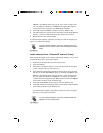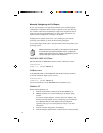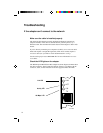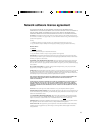18
Fast Ethernet Wiring
100BASE-TX Specification: The 100BASE-TX specification supports 100
Mbps transmission over two pairs of category 5 twisted-pair Ethernet (TPE)
wiring. One pair is for transmit operations and the other for receive
operations. Segment lengths are limited to 100 meters with 100BASE-TX for
signal timing reasons. This complies with the EIA 568B wiring standard.
Fast Ethernet Hubs and Switches
The two basic types of hubs are shared hubs and switching hubs. Ether-
Express PRO/100 TX adapters can be used with either type of hub for 10
Mbps. At 100 Mbps, a TX hub or switch is required.
Shared hubs
In a shared network environment, computers are connected to hubs called
repeaters. All ports of the repeater hub share a fixed amount of bandwidth, or
data capacity. On a 100 Mbps shared hub, all nodes on the hub must share the
100 Mbps of bandwidth. As stations are added to the hub, the effective band-
width available to any individual station gets smaller. Shared hubs do not
support full duplex.
Think of a shared repeater hub as a single-lane highway that everyone shares.
As the number of vehicles on the highway increases, the traffic becomes con-
gested and transit time increases for individual cars.
On a shared hub all nodes must operate at the same speed, either 10 Mbps or
100 Mbps. Fast Ethernet repeaters provide 100 Mbps of available bandwidth,
ten times more than what’s available with a 10BASE-T repeater.
Repeaters use a well-established, uncomplicated design, making them highly
cost effective for connecting PCs within a workgroup. These are the most
common type of Ethernet hubs in the installed base.
Switching hubs
In a switched network environment, each port gets a fixed, dedicated amount
of bandwidth. In the highway scenario, each car has its own lane on a multi-
lane highway and there is no sharing.
In a switched environment, data is sent only to the port that leads to the pro-
per destination station. Network bandwidth is not shared among all stations,
and each new station added to the hub gets access to the full bandwidth of the
network.
If a new user is added to a 100 Mbps switching hub, the new station receives
its own dedicated 100 Mbps link and doesn’t impact the 100 Mbps bandwidth
of another station. Switching hubs can effectively increase the overall
bandwidth available on the network, significantly improving performance.
Switching hubs can also support full duplex.
For more information on Fast Ethernet, visit our Network Products
website (see page 1).


















